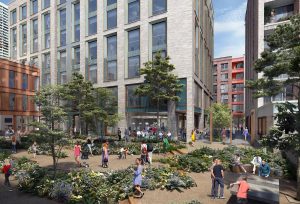Q&A with Richard Hart, Design Manager at First Base
14th March 2019Richard Hart is the Design Manager for First Base, a mixed-use developer which, in partnership with Patrol Capital, owns the Edward Street Quarter development in Brighton.
Designed by BuckleyGreyYeoman, Edward Street Quarter is inspired by Brighton’s eclectic street scene and will introduce a new high-quality public realm, with three new public spaces created by renowned landscape designers Spacehub.
The scheme will also deliver 110,000 sq. ft of flexible space for Brighton’s burgeoning media and creative sectors and wider corporate community, making it the largest provision of workspace to be delivered in the city since 1993.
Edward Street Quarter will also comprise 168 new  homes, comprising a mix of private and affordable units to meet local demand, as well as 40,000 sq. ft targeting food and beverage, gyms, cinemas and retail units.
homes, comprising a mix of private and affordable units to meet local demand, as well as 40,000 sq. ft targeting food and beverage, gyms, cinemas and retail units.
Can you give some details into your back-story in the industry?
I started working in the print room of a large commercial architecture firm when I was 17. From there, a day release course at the West London College of Building led me to the University of Huddersfield, where I completed a BA and later a Master of Architecture. After working on major projects both here and overseas, I decided I needed a new challenge, and decided to look for opportunities within the property development industry.
What excites you most about working in property development?
People are at the heart of property development. When you are involved in a large project, there are numerous people and teams working on different aspects. Strong communication and working relationships between these people and teams is key to the success of a project. One of the biggest pleasures of my job is establishing and developing these working relationships.
I also love that no two days are the same. Every day brings different tasks and challenges as situations develop quickly in this business, which you need to be able to quickly react and respond to.
What is your proudest achievement?
It’s extremely hard to pick a single specific achievement, given the wide range of sectors that I’ve worked across. However, I’m extremely proud of my work on projects that have made a direct difference to people’s lives, so projects that incorporate health, education, housing and placemaking. The Jack Petchey Academy, in Dalston, replaced a run-down secondary school, with an inspirational building the pupils took great pride in. The redevelopment of Forrest Place, in Perth, WA, breathed new life into a tired, disconnected city square, which linked the main rail station with the city centre. Two contrasting schemes, which had a tangible impact on the end users and the wider community.
What kind of research do you do to keep up with market and technology trends? Can you give an example?
First Base is always on the lookout for the next big trend and recently sent me to Lyon to study the city’s external lighting policy. Extensive research commissioned by the city’s local government has shown that placing bright lighting in dimly lit spaces that attract crime is not the best method of deterring antisocial behaviour.
The lighting strategy gives the city a cohesive feel after dark. Unlike other cities, there are no dominating landscapes in Lyon. This strategy has also resulted in other benefits such as lower energy bills for the city and an enhanced sense of pride from residents. The opportunities to witness technological and design innovations, such as this example, have certainly had an influence on how I approach new design projects.
Looking at Edward Street Quarter, what are the key things you are thinking about when considering internal design?
Every market has different design requirements, so we don’t roll out a single cookie-cutter solution to every project. The location and demographics of the development are extremely important when considering the design of internal space.
However, as a rule of thumb, internal spaces must flow, as their success is largely based on how people move through these spaces. Good sight lines are also of essential importance in that they help to amplify the feeling of spaciousness.
One of the things that we are really thinking about regarding the Edward Street development is colour psychology; getting the right palette is critical to any scheme’s success. When using colour, we are careful about following current trends in the market. While we try to be innovative in our use of colour, we are also mindful that current trends can have limited shelf-lives and by the time our project is finished their time in the sun may have passed.
How have tastes changed in the last ten years? How can you future-proof internal designs to ensure they don’t date too quickly?
One of the big changes is that buyers are a lot more informed and sophisticated and thus design has become more important to them. Innovative design in consumer products, such as smartphones, have brought design to the forefront of people’s minds. People often consider appearance to be as important as price and functionality when considering what they want to buy.
In terms of future-proofing, this is one of the biggest challenges facing designers currently. But there are some things that never go out of fashion, such as products with timeless colours, good craftmanship and quality materials.
Advertise your business or charity initiative in the Sussex Business Times. Call 01323 819007 or 07894762304. Alternatively, email sam@thebusinessgroup.co.uk




